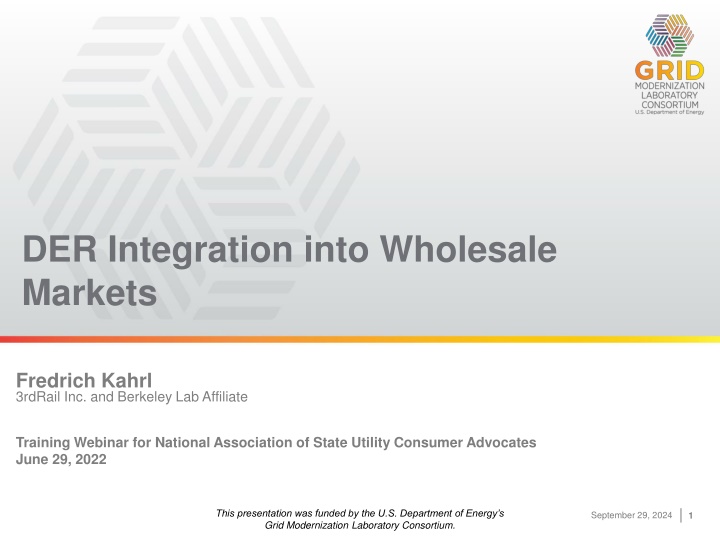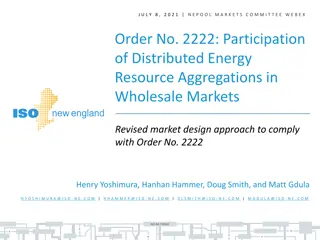DER Integration into Wholesale Markets - Key Considerations and Priorities
Distributed Energy Resource (DER) integration into wholesale markets is crucial for enhancing coordination between distribution and transmission systems. This process involves addressing barriers, identifying priorities, and exploring closer coordination opportunities. Key aspects include DER interconnection, planning, data access, system operations, regulation, and market integration. The presentation emphasizes the importance of strategic DER placement and value optimization for efficient grid operations and cost savings.
Download Presentation

Please find below an Image/Link to download the presentation.
The content on the website is provided AS IS for your information and personal use only. It may not be sold, licensed, or shared on other websites without obtaining consent from the author.If you encounter any issues during the download, it is possible that the publisher has removed the file from their server.
You are allowed to download the files provided on this website for personal or commercial use, subject to the condition that they are used lawfully. All files are the property of their respective owners.
The content on the website is provided AS IS for your information and personal use only. It may not be sold, licensed, or shared on other websites without obtaining consent from the author.
E N D
Presentation Transcript
DER Integration into Wholesale Markets Fredrich Kahrl 3rdRail Inc. and Berkeley Lab Affiliate Training Webinar for National Association of State Utility Consumer Advocates June 29, 2022 This presentation was funded by the U.S. Department of Energy s Grid Modernization Laboratory Consortium. September 29, 2024 September 29, 2024 1 1
Overview Background: Distributed energy resource (DER) integration into wholesale markets Barriers to DER integration Nearer-term priorities for DER integration Longer-term priorities for DER integration Key considerations for public utility commissions Questions public utility commissions can ask September 29, 2024 September 29, 2024 2 2
Background: What is DER integration and why is it important? (1) DER integration refers to the integration of DER into distribution system operations and wholesale markets and operations, enabling closer coordination between distribution (D) and transmission (T) system planning and operations. Better T-D coordination will reduce required electricity system investment and operating costs. DER integration covers a wide range of areas: DER interconnection, T&D planning, data access and communication, distribution system operations, utility regulation and tariffs, and wholesale markets. NYISO has a generator outage and low wind, leading to high energy prices Transmission (NYISO) ISO-NE has a cloudy day with limited solar generation, leading to high energy prices Transmission (ISO-NE) Distribution Utility C Distribution Utility B Distribution Utility A Coordinated T-D operations example Distribution customers with storage shift discharging to system peak hours, and customers with responsive load reduce output (e.g., EVs charge as little as possible). September 29, 2024 September 29, 2024 3 3
Background: What is DER integration and why is it important? (2) NYISO relies more on imports from ISO-NE to meet resource adequacy (RA) needs Transmission (NYISO) ISO-NE reduces total RA need and T investments Transmission (ISO-NE) Distribution Utility C Distribution Utility B Distribution Utility A Coordinated T-D operations example Distribution customers invest in a significant amount of distributed generation, distributed storage, and load management that is coincident with ISO-NE and NYISO peak demands. September 29, 2024 September 29, 2024 4 4
Background: Storage placement illustrates why DER integration is important Better coordination between D and T systems can resolve the question of how much storage should be optimally located in different parts of the electric grid, based on where it has the most value for the lowest cost. From a regulator s perspective, it s important to think about value and cost to whom ? September 29, 2024 September 29, 2024 5 5
Background: Approaches to DER participation in wholesale markets Under FERC Order 2222, DER can participate on the supply side individually or through aggregation by making offers directly into ISO markets. ISO directly settles with DER owner or aggregator DER can also participate in ISO markets on the demand side through LSE demand bids or metered demand. ISO settles with LSE, DER offsets LSE ISO charges, and LSE settles with DER owner or aggregator. DER Supply-side offers DER Generator aggregator ISO Demand-side bids (day-ahead market) and metered demand (real- time market) Competitive LSE Utility LSE DER DER September 29, 2024 September 29, 2024 6 6
Key elements in DER integration Distribution Interconnection Utility assesses DER impacts on D system, determines whether D upgrades will be needed Distribution Operations and Markets Utility ensures D reliability, may operate DER to avoid reliability violations (and in the future potentially to minimize D costs subject to D security constraints) Wholesale Markets ISO ensures T reliability, operates markets for RA, day-ahead/real-time energy and ancillary services Distribution Planning Utility pre-emptively builds D infrastructure, determines upgrades that will be triggered through interconnection and how DER will be operated Utility Regulation and Tariffs State regulators determine utility incentive framework and approve tariffs and rates September 29, 2024 September 29, 2024 7 7
Barriers to DER integration (1) DER interconnection Interconnection standards Many states have yet to adopt and implement IEEE 1547-2018 (focused on smart inverters and voltage support). Process enhancement and standardization Coordination among states is limited in terms of distribution interconnection enhancements (timelines, technical requirements, upgrade cost allocation). Interconnection costs Cost allocation methods are in flux. States are still at an early stage in allowing DER to avoid D upgrades in exchange for limiting generation or being curtailed in some hours ( flexible interconnection ). Distribution planning T-D planning coordination D utilities and ISOs have limited coordination on load/DER forecasts and engineering studies. Regional resource planning coordination Coordination is limited among ISOs, state PUCs and energy offices, utilities, generators, and DER developers on scenarios for regional resource development. September 29, 2024 September 29, 2024 8 8
Barriers to DER integration (2) Distribution operations DER overrides Most utilities do not yet have processes for overriding ISO dispatch of DER aggregators, including outage communication capabilities. DSO functionality and grid investments There is a lack of clarity over future monitoring, communications, and dispatch/control needs and investment requirements. Utility regulation and tariffs Utility incentives Utilities may not have incentives to maximize the value of DER. DER tariffs Many utilities do not have time-varying, market-based tariffs for customers that can shift load and have behind-the-meter generation. Wholesale markets Demand participation Opportunities for intraday participation in ISO markets through demand bids are limited. State-federal jurisdiction Overlapping jurisdiction Federal-state jurisdiction over distribution interconnection, planning, operations, and markets remains unclear in some cases. September 29, 2024 September 29, 2024 9 9
Nearer-term priorities DER interconnection Adopting and implementing IEEE 1547-2018 Investing in interconnection process improvements, with some amount of regional or national standardization Allowing static export limits for distributed generation paired with storage* Distribution planning Coordinating DER/load forecasting for T-D systems; undertaking what if regional resource scenario analysis through regional fora DER operations Developing transparent, non-discriminatory approaches to DER overrides that can evolve into more active distribution operations over time Beginning to consider future models for distribution system operations and mapping out needed investments over time Utility regulation and tariffs Exploring incremental improvements to utility performance incentives and time-of- use-based tariffs for DER customers State-federal jurisdiction Establishing a FERC-state working group on distribution jurisdiction * See, for instance, Use of Operating Agreements and Energy Storage to Reduce Photovoltaic Interconnection Costs, https://eta-publications.lbl.gov/sites/default/files/80556.pdf September 29, 2024 September 29, 2024 10 10
Longer-term priorities DER interconnection Implementing more flexible approaches to interconnection of DER and EV loads, eventually allowing dynamic curtailment (dispatch) of DER Distribution planning Developing new planning criteria for D investments (e.g., moving toward a reliability, economic, policy framework like the T system) DER operations Right-sizing the sophistication of utility distribution operations (e.g., how actively do DSOs need to manage D systems?) Utility regulation and tariffs Creating open access rules for the distribution system Developing multi-part tariffs for DER customers, with more sophisticated time- varying distribution rates Developing future utility business models (e.g., balancing cost recovery and economic bypass of grid charges) Wholesale markets Allowing intraday demand bids and locational marginal pricing settlement for loads September 29, 2024 September 29, 2024 11 11
Key considerations for public utility commissions Starting from fundamentals Taking a bottom-up approach to problem solving, being clear about terms and concepts (e.g., be careful with the term DER ), and developing a working framework of options for future distribution operations and markets Focusing on least-regrets In the near term, focusing resources on incremental, least-regrets changes that build on existing institutions Keeping a long-term perspective Starting to think about solutions to longer-term challenges, creating a vision for future distribution system operations and markets, and developing a long-term plan that prioritizes areas to tackle over time Working together Participating in regional/national fora and learning from other jurisdictions September 29, 2024 September 29, 2024 12 12
Questions state utility consumer advocates can ask Where are nearer-term gaps in current distribution interconnection, distribution planning and T-D planning coordination, distribution operations, and utility DER tariffs? How can nearer-term gaps be most effectively and efficiently addressed, while laying the foundations for a transition to future distribution system operations and markets? What is the longer-term vision for future distribution system operations and the role (and business model) of the distribution utility? Where would clearer state-federal jurisdiction be most helpful in the nearer and longer term? Where are opportunities for public utility commissions to work together on DER integration, and what balance between regional (e.g., NECPUC) or national (e.g., via NARUC) fora would provide the most helpful venue for collaboration? September 29, 2024 September 29, 2024 13 13
Resources for more information Energy Systems Integration Group (ESIG), 2022, DER Integration into Wholesale Markets and Operations, https://www.esig.energy/wp- content/uploads/2022/01/ESIG-DER-Integration-Wholesale-Markets- 2022.pdf Advanced Energy Economy (AEE) and GridLab, 2022, Removing Barriers to DER Participation in Wholesale Markets, https://gridlab.org/wp- content/uploads/2022/01/eLab-Accelerator-DER-Wholesale-Markets.pdf Advanced Energy Economy (AEE) and GridLab, 2022, FERC Order 2222 Implementation: Preparing the Distribution System for DER Participation in Wholesale Markets, https://gridlab.org/wp- content/uploads/2022/01/AEE-GridLab-FERC-O.2222-Campaign-Final- Report.pdf September 29, 2024 September 29, 2024 14 14
Contact Fritz Kahrl 3rdRail Inc. fkahrl@outlook.com Lisa Schwartz Lawrence Berkeley National Laboratory lcschwartz@lbl.gov September 29, 2024 15






















